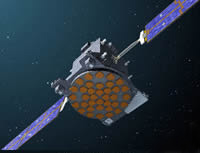| Рубрикатор |  |
 |
| Все новости |  |
World News |  |
 |
Galileo Celebrates Milestone
| 11 января 2008 |
The first of Europe’s satellite navigation program, the Galileo, is celebrating two years of successful in-orbit operation. GIOVE-A (Galileo In-Orbit Validation Element) secured a vital Galileo frequency filing with the International Telecommunications Union (ITU) and supported the development of technology critical to Galileo’s future.
The 660kg (1,455.05 lbs.) satellite was developed by SSTL (Surrey Satellite Technology Ltd) for the European Space Agency (ESA) to broadcast Galileo signals from space and claim the frequencies filed with the ITU for Europe. In a short 30-month development program, SSTL designed, built and tested the first Galileo satellite, while remaining within a 28 million euro budget, and sent the Galileo into orbit on December 28, 2005. Awaiting indications that all was successful took 15 days. On January 12, 2006, at 17.25 Greenwich Mean Time, the signals that all had been waiting to hear were transmitted. Other good news followed, when the ESA confirmed that they had brought the Galileo-related frequency filings into use three months ahead of the official ITU deadline.
Much has transpired since then, including the ESA increased GIOVE Mission Segment. The Galileo Experimental Sensor Stations (GESS), which are worldwide, and the GIOVE Processing Center, which tracks the GIOVE A navigation signals to create orbit models and produce navigation messages, are all examples of success. This is important as it enables the ESA to review the instruments on-board the satellite and the receivers on the ground and perform tests that confirm the mission’s success. The ESA has performed clock characterization experiments that test the onboard rubidium atomic frequency clock, with results indicating that the clocks are highly accurate, and will supply technology that is of primary importance to the future of Galileo satellites.
The SSTL satellite sets the pace as a pioneer for traveling in the Medium Earth Orbit (MEO) location, and securing the task of transporting its payload, which will be significant is supplying information for future SSTL missions. Already ramping up for another spacecraft for the Galileo satellite navigation system, the ESA was awarded a second contract in March. Aptly named the GIOVE-A2, the satellite will cost 25 to 30 million euros to provide a follow-on mission to ensure signal continuity. The next phase will be a huge task that will cost 3.4 billion Euros and will provide a constellation of 30 satellites in a worldwide network of ground stations to be activated by 2013—Guildford, United Kingdom.
Источник: http://www.satnews.com
















Оставить свой комментарий:
Комментарии по материалу
Данный материал еще не комментировался.